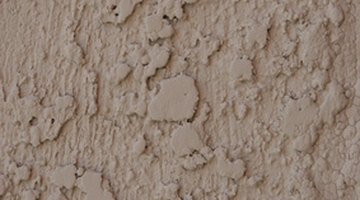Ideas for Covering the Exterior of a Cinder Block Basement
Cinder blocks, which are hollowed concrete blocks, are often preferred when building the walls of foundations and basements as they are inexpensive, durable and easier to erect than solid concrete. The negative side of cinder blocks is that they are grey, dull and unattractive.

If your cinder-block basement is an eyesore in the landscape of your home, there are attractive concealment options.
Stucco
An easy textured finish can be applied to cinder blocks using a cement surface coating product such as Sakrete Bonding Cement or Thoroseal Waterproof Coating. Begin by digging out the ground around the walls at least 4 inches deep then cleaning them thoroughly with biodegradable concrete cleaner. Apply an initial thin coat followed by a thicker, textured coat. Keep the wall wet as you work. The texture is up to you. Texture possibilities include trowel distressed, sponge mottled or broom brushed. The coating can also be tinted with concrete pigment before application or it can be painted or stained with concrete stain or concrete paint after it cures.
Climbing Plants
A natural element can be added to your home's exterior by allowing climbing plants to take over the cinder-block walls. Affix lattice to the cinder block using concrete screws. Use spacers under the lattice so vines have room to creep behind the lattice. Drill pilot holes for the screws using a drill with a masonry bit. Manufactured lattice can be used or build your own rustic lattice out of dried branches. Paint or seal unfinished lattice to prevent moisture and UV damage. Plant climbing plants along the base of the lattice. Types of evergreen climbers that will keep the cinder blocks covered year round include ivy, akebia, clematis and Carolina jessamine.
Artificial Stone
Artificial stone is a wall veneer made from aggregate and binders that have been cast to look like natural stone. Many styles are available, including slate, field stone, river rock and brick. Dig trenches at least 4 inches deep along the walls and clean them with biodegradable concrete cleaner. Keeping surfaces damp as you work and secure the stones with mortar. After the mortar cures, fill the joints between stones with grout, using a grout bag. Smooth down the grout, using the end of a round dowel, a jointer tool or a narrow palette knife with a rounded end. Optionally, the grout can be tinted with concrete pigment to better complement the color of the stones. Once the grout cures, paint it with grout sealer.
The Drip Cap
- Cinder blocks, which are hollowed concrete blocks, are often preferred when building the walls of foundations and basements as they are inexpensive, durable and easier to erect than solid concrete.
- Begin by digging out the ground around the walls at least 4 inches deep then cleaning them thoroughly with biodegradable concrete cleaner.
- Keep the wall wet as you work.
- Many styles are available, including slate, field stone, river rock and brick.
- After the mortar cures, fill the joints between stones with grout, using a grout bag.
- Optionally, the grout can be tinted with concrete pigment to better complement the color of the stones.
References
Writer Bio
Mason Howard is an artist and writer in Minneapolis. Howard's work has been published in the "Creative Quarterly Journal of Art & Design" and "New American Paintings." He has also written for art exhibition catalogs and publications. Howard's recent writing includes covering popular culture, home improvement, cooking, health and fitness. He received his Master of Fine Arts from the University of Minnesota.
Photo Credits
- stucco texture image by MAXFX from Fotolia.com
- stucco texture image by MAXFX from Fotolia.com
More Articles



